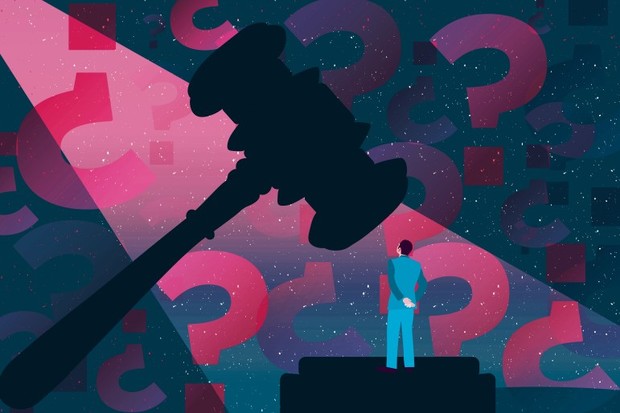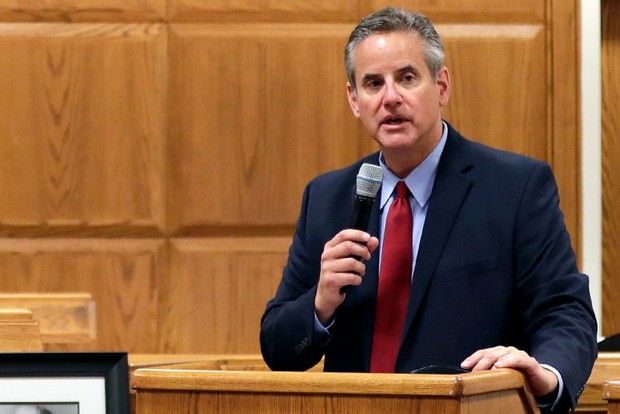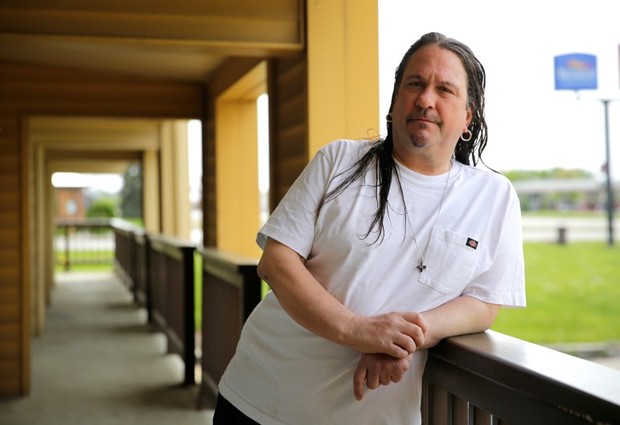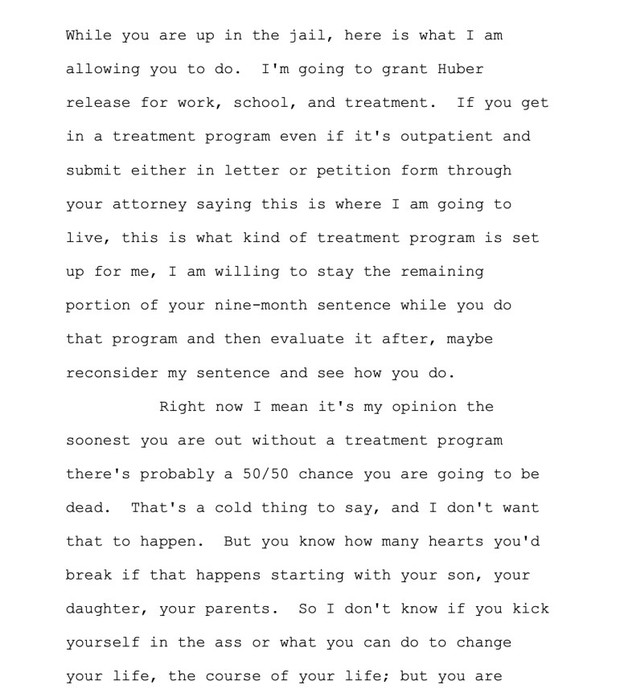
By Mario Koran, Phoebe Petrovic, Madeline Fuerstenberg and Jack Kelly,
Wisconsin Watch
In September 2015, Charles Joe Reuter IV knew two things for certain: He needed help to beat his growing dependence on opiates — a habit that landed him behind bars, waylaid his career goals and separated him from his two children — and he was not going to get the treatment he needed in jail.
The then-29-year-old Appleton man faced jail time for a domestic battery conviction, one of several drug-fueled crimes he had committed after 16 years of drug use morphed into destructive heroin addiction.
Had Reuter served his sentence in jail, he would have been free in less than five months. But when Outagamie County Circuit Court Judge Vincent Biskupic agreed to pause his jail time so he could attend treatment — a practice he has done in more than a dozen other cases — it sounded like a smart option.
“I’ve never gone to jail and then gotten out and been better for it,” Reuter told Wisconsin Watch.
“It’s dry time. You’re not going to be getting high. But at the same time, you’re not having any type of treatment or rehabilitation. So it’s very hard to get out and be any different.”
On its face, the arrangement that Biskupic explained in court to Reuter sounded straightforward:
Attend treatment, remain sober and update the court on treatment progress. Whether Reuter would have to serve the time that remained on his jail sentence would be determined by his progress, Biskupic indicated.
But as addiction recovery often goes, Reuter made progress, then slid backwards. He attended multiple treatment centers, each one followed eventually by a relapse, each relapse followed by additional court proceedings.
Biskupic’s approach looks a lot like one taken by a drug court, a model that typically offers offenders a way to minimize legal consequences if they remain sober, crime-free and participate in a structured program. Outagamie County has offered a drug and alcohol treatment court since 2009. But Reuter was not in it.
Instead, he found himself in an ad hoc drug court run by Biskupic — one without a clear timeline and with expectations that often changed. And it has left the arrangement open to the same criticism that some experts level against drug courts; namely, longer punishment for those who fail to meet demands.
Biskupic declined to be interviewed for this story. But in a statement emailed by his attorney, Biskupic said that judges, attorneys and social workers in Outagamie County have sought sentencing options that allow defendants to seek treatment for drugs and alcohol in response to a 10-year rise in crimes related to substance abuse. Biskupic said none of the cases have been appealed or reversed by higher courts — suggesting the approach was not problematic.

Between September 2015 and January 2018, Reuter was scheduled to meet with Biskupic at least 13 times for so-called review hearings, formal check-ins to update the judge on his life and treatment progress. Attendance was mandatory. On one occasion, after Reuter missed a court appearance, Biskupic issued an arrest warrant. The judge set no date for when the supervision would end.
But the continuous monitoring did not help Reuter’s case before Biskupic. In 2018, after Reuter walked away from a treatment program, Biskupic finally ordered him back to jail to sit the remainder of his sentence. He awarded Reuter no credit for the time he spent in treatment.
For Reuter, a sentence that would have meant less than five months in jail stretched on for more than two years. His was not an isolated case.
In 2016, Biskupic temporarily released from jail another defendant, Christopher Kartsounes, so he could attend drug and alcohol treatment. Kartsounes did so, but Biskupic then refused to close his case until he found stable housing. Eventually, Kartsounes relapsed. After he did, Biskupic ordered him back to jail to complete his sentence. Had Kartsounes simply sat his jail term from the beginning, he’d have been free more than six months earlier.
Kartsounes struggled to find permanent housing while his case with Biskupic remained open and said the open-ended sentence accelerated a downward spiral that eventually landed him in prison.
Reuter was more equivocal. He said he holds no animosity toward Biskupic, whom he described as a “caring judge,” and accepts responsibility for not remaining sober. But he also recognized that the small degree of freedom Biskupic gave him ultimately hurt him.
“Give someone enough rope, they’ll hang themselves,” Reuter said.
Stayed sentences, vague promises
In some cases, Biskupic has embraced an open-ended approach to sentencing since he was appointed to the bench in 2014 by then-Gov. Scott Walker. According to Wisconsin Watch’s statewide analysis of electronic court data, only a small handful of judges handle cases in a similar manner in Wisconsin — and Biskupic is by far the biggest practitioner.
Over the past seven years, Biskupic has used the tactic not just for those struggling with addiction, but also as an incentive for defendants to obtain their GEDs or pay fines, restitution and court costs. In court, he used vague language to explain the arrangements, setting no end-date for the supervision. Instead, explanations often carried an implicit promise: If defendants fulfill the obligations Biskupic imposes, they could close their cases and avoid additional jail time.

Within that time, Biskupic called at least 46 defendants involved in 52 cases back to court for repeated review hearings — demanding updates about the status of their court-ordered payments, work-searches and treatment progress — and issued arrest warrants for people who failed to appear, court documents show.
The sentences Biskupic issued to defendants typically depended on their sobriety. All had been on probation — a sentence that allows someone to remain in the community so long as they stay crime-free, report to a probation agent and follow a list of rules — but had their probation revoked for violating rules before they began their supervision under Biskupic.
Typically, judges send defendants to jail or prison when their probation is revoked. But Biskupic instead effectively sentenced some defendants to open-ended arrangements by “staying” their sentences, pausing their jail term while they attended drug and alcohol treatment.
In theory, the arrangement offers advantages for defendants who agree to the deals, potentially allowing them to avoid additional jail time or close their cases early. But for defendants like Kartsounes and Reuter, the months spent in treatment only added to the time they spent under Biskupic’s supervision.
They were not alone. Of the 16 defendants whose sentences Biskupic paused so they could attend drug or alcohol treatment, at least 11 had to return to jail after they participated in treatment, whether they remained in lock-up or were allowed to leave jail for work.
When Biskupic sentenced Reuter, he explained that he would pause his remaining jail time and reconsider the punishment upon completion of substance abuse treatment.
“I am willing to stay the remaining portion of your nine-month sentence while you do that program and then evaluate it after, maybe reconsider my sentence and see how you do,” Biskupic said in September 2015.
But it remains unclear whether he has the legal authority to impose such a sentence. About two dozen legal experts consulted by Wisconsin Watch had a wide range of views about Biskupic’s use of review hearings. Some said the practice is legal, some called it a gray area and some said it has no basis in state law. Others had never heard of it before.
Attorneys from the State Public Defender’s Office (SPD) office have helped notch such deals for their clients. The office declined an interview for this story and said it could not speak to individual cases, but spokesman Willy Medina said in a statement that the alternative arrangements can benefit clients by helping them avoid jail time — if they comply with the judge’s conditions.
“SPD attorneys work to give their clients the best options available, explaining the potential outcomes and letting them make decisions about their future,” Medina said.
Sobriety, with a carrot and stick
As the war on drugs ramped up in the late 1980s, drug courts emerged as an avenue to keep low-level drug offenders from filling jails and prisons and accruing convictions that would remain on their criminal histories.
They have become increasingly popular over the past 30 years, benefitting from bipartisan support. Proponents have appealed to both conservatives and progressives by framing them as a treatment-over-punishment model that saves costs by reducing recidivism. They are “designed to stop crime by treating substance use disorders and other serious problems underlying criminal conduct,” according to the National Institute of Justice.
Drug courts fall under the larger umbrella of so-called problem-solving courts, which give specific groups a way to avoid criminal convictions if they fulfill any number of conditions a judge imposes. Treatment courts can look slightly different depending on the jurisdiction, but typically follow standards set forth by Wisconsin Association of Treatment Court Professionals.
Outagamie County runs not just a drug and alcohol court, but also a court designed for veterans — which Biskupic oversees — another for defendants with mental health issues, and a court that allows low-level defendants to avoid formal probation with the state’s Department of Corrections if they complete a structured program.
Criteria for admission varies by the type of court, but offenders convicted of violent crimes are typically excluded from the outset, in accordance with guidance outlined in the state law that authorized treatment courts.
Some drug and alcohol courts offer low-level offenders a way to avoid criminal convictions upon successful completion of the program. In Outagamie County, it is primarily offered as a way for people on probation to avoid prison pending completion of the program, said Circuit Court Judge Mitchell Metropulos, who oversees the drug and alcohol court.
“Our clients typically have failed past attempts on probation and with treatment. Our court allows them to be subjected to more intense supervision and treatment. If they fail our court they will likely have their supervision revoked and will go to prison or face a lengthy county jail term,” Metropulos said.
Traditionally only about one-third of offenders who complete drug court programs later commit new crimes, he added, compared to two-thirds of those who are incarcerated or complete traditional probation.
“So the payback is pretty good, but we throw a lot of resources at these folks,” Metropulos said.
“And I think that’s pretty much across the board in Wisconsin and the nation with regards to treatment courts.
Participants can complete the drug court program in a year, Metropulos said, but more typically take at least a year and half to finish. At the outset, participants receive a drug and alcohol assessment and begin treatment — either in a residential, clinical setting or at an outpatient provider within the community. They undergo counseling to challenge their “criminal thinking” patterns and attend recovery support groups, Metropulos said. Those who need stable housing are often routed to sober living houses, typically group homes that require abstinence from drugs and alcohol.
A team of professionals guide participants through drug court, including a program point-person who coordinates treatment services, a probation agent who meets regularly with participants and a representative from a treatment provider. The drug court judge and representatives from both the district attorney’s and public defender’s office also take part in the program.
County funding is available to cover treatment costs for participants who lack health insurance, but participants typically pay a $40 monthly fee for the cost of drug testing, said Metropulos.
Bernie Vetrone, director of criminal justice treatment services for Outagamie County, said participants are tested for drugs three times a week. In court, each participant — there can be up to 20 in the program — stands before the judge and talks about how their week has gone. If the team determines they are making progress, they may be rewarded with a $5 gift card to a convenience store — a measure of positive reinforcement.

“Treatment court is all about positive reinforcement because what we’ve found in criminal justice is that positive reinforcement works much better as a behavioral modification tool than negative reinforcement,” Vetrone said.
But sanctions and punishments are a feature of the program, too. Metropulos said the drug court embraces a “medical model,” offering more intensive treatment to participants who relapse on drugs or alcohol, while “criminal mindset” behavior like lying or attempting to cheat a drug test is met with increasingly harsh punishment, ranging from a few days or weeks in jail up to termination from the program.
“Eventually we have to tell them, if you can’t be honest with us, you can’t show up to seriously engage in treatment, you continue to manipulate us, we will have to look at termination,” he said.
Those who succeed in treatment court gradually earn new freedoms or face fewer check-ins, and could potentially close their cases early. But those who fail can pay a heavy price, having to serve the time behind bars they were hoping to avoid by participating in drug court.
‘Skipping the middleman’
The approach Biskupic has taken to sentencing shares similarities with the official drug and alcohol court, with one important distinction: In his court, Biskupic alone called the shots. Regular review hearings stood in for the weekly court appearances required by the drug court program. He had no treatment team beside him or structured program to offer.
Those Biskupic ordered to attend drug and alcohol treatment were often referred to a specialist contracted by the county’s department of health and human services who helped them locate treatment facilities or link them to services.
Those resources, available to all county residents, were not specific to people involved in the criminal justice system. It often fell on defendants to contact the coordinator and secure their place in a treatment program, court records indicate — no easy task for those without free access to phone and internet after being taken into custody following a revocation.
Alicia Cook, who for more than six years served as the county’s contracted alcohol and drug specialist, said her position evolved as word spread among inmates and criminal defense attorneys that she could help people find treatment. Cook said she spent the bulk of her time in this role calling around to treatment facilities looking for openings appropriate for the individuals.
“Because of the heroin crisis, because of the amount of people who were becoming incarcerated, because of the amount of people who were out in the world who are dying of overdoses, judges became more open to the idea of having a person bail bonded so that they could go into residential treatment,” Cook said.
In Biskupic’s version of drug court, he would pause a defendant’s jail term by “staying” their sentence while they completed treatment. Depending on their progress, he could either stay that sentence permanently — saving them from additional jail time — or, if defendants floundered, he could lift the stay, sending defendants back to jail to resume their jail sentences.
Vetrone, whose department helps coordinate a number of programs for offenders in the county, was not immediately familiar with Biskupic’s alternative approach when contacted by Wisconsin Watch. But he described Biskupic as a diligent judge who works hard to understand the factors that drive someone’s criminal behavior.
As someone who worked in probation and parole for 20 years, Vetrone sees Biskupic’s approach as one that could offer more accountability and “hands-on contact” to low-level offenders who may fall through the cracks of the traditional probation system, which often forces probation agents to spend more time and energy on offenders who committed the most serious crimes.
“Is it normal? Not really. But is it inappropriate? No, not, in my opinion,” Vetrone said of Biskupic’s approach.
“I think this is a case of a judge being concerned with certain people that come before him. And trying to go that extra step to make sure that this person can be rehabilitated and not fall through the cracks,” Vetrone said. “So, I have absolutely no concerns with this. It’s a little unorthodox, maybe, but nothing I’d be concerned about.”
Vetrone said it is not uncommon for treatment courts to refer participants to outside parties for services — a veteran’s court participant, for example, may be referred to the federal Veterans Administration to address certain needs. Biskupic is effectively performing the services of a case manager, he said.
“Judge Biskupic is just skipping the middleman and just doing it directly himself,” Vetrone said. “In essence, he’s doing the same thing we would do.”
Indeed, Biskupic’s approach has much in common with a typical drug and alcohol court, including the fact that both can result in longer sentences and harsher punishment for those who do not successfully complete their obligations.
Drug court criticism
Over the past two decades, as an opiate crisis fueled by pharmaceutical companies gave way to a heroin epidemic that ravaged rural America, more states and counties have established drug courts. Nationally, about 3,700 drug courts exist today. But as the treatment model proliferated, a growing number of researchers and experts have raised concerns that their benefits have been exaggerated — and the risks minimized.
“Drug court success stories are real and deserve to be celebrated,” reads a report from the Drug Policy Alliance. “However, drug courts also leave many people worse off than if they had received drug treatment outside the criminal justice system, had been left alone, or even been conventionally sentenced. The successes represent only some of those who pass through drug courts and only a tiny fraction of people arrested.”
To Kerwin Kaye, an associate professor of sociology at Wesleyan University who wrote about the unintended consequences of drug courts in his book Enforcing Freedom, one of the most understated concerns over the model is that about half of all drug court participants ultimately fail the program. But this detail is not always made clear to people before they agree to participate, he said.
“Fifty percent is not an insignificant number. You need to make a big deal of that” when explaining the program to defendants, Kaye said.
Standards written by the Wisconsin Association of Treatment Court Professionals require that participants be informed in advance that they may face an extended sentence if they fail to complete the program.
Even so, failure looms large even for Outagamie County’s official drug and alcohol court. Between 2014 and 2020, 57 of the 253 people who participated in the program graduated, according to data obtained through the state’s open record law. That would mean 77% of participants fell short within that period, excluding the few people who were withdrawn from the program for administrative reasons.
But because participants begin and finish the program on different timelines, Metropulos said it is more accurate to compare the number of those terminated to those who graduate, which would represent a 50% completion rate — in line with the national average.
In his research, Kaye found that drug court coordinators often fail to properly underscore the consequences of failing to complete a program before participants agree to it.
“A problem with drug courts in general is that they don’t explain the deal ahead of time: ‘There’s a 50% chance you might not make it, you might fail. In which case, by the way, you would have wasted all this time under court supervision, and now you’re going to get the full sentence because you’ve already had to plead guilty to participate in most drug courts,’” he said.
While Kaye understands Biskupic is not running a formal drug court, he said the same risks apply to his model. In fact, he said, the risks may be even more pronounced with what Biskupic has established — in part because Biskupic has no treatment team alongside him to help support and monitor defendants.
‘I can’t do much more’
Unclear expectations were the case for Kartsounes, who mistakenly believed his remaining jail time would be waived if he completed treatment. Kartsounes said he had never heard about an open-ended arrangement like Biskupic’s until the judge offered the option in court.
And even with guidance from a public defender, he said, he only understood the deal in its broadest terms. In the end, Kartsounes said his prolonged case with Biskupic led to further legal trouble that ultimately landed him in state prison.
Reuter, too, ended up worse off after Biskupic granted him perceived latitude. In the nearly two years his case with Biskupic remained open, he attended four separate treatment programs, including one in South Carolina. During periods of sobriety, Biskupic praised Reuter and encouraged him to keep pursuing his education at Fox Valley Technical College, where he studied marketing and business management.
But in 2018, after he walked away from a local treatment program before completing it — which he described in court as a “bonehead decision” driven by a compulsion to get high — Biskupic finally ordered him back to jail to complete his sentence.
“This file has to wind down. You have done more than most people,” Biskupic told Reuter, adding later: “We’re to the point where, you know, at least from my situation, I can’t do much more.”
Like Kartsounes, Reuter was not credited for the time he spent in treatment. To Kaye, that represents one of the biggest concerns, both for Biskupic’s version of drug court and for treatment courts writ large.
“Don’t penalize people for trying to do treatment. You should, under no circumstances, end up with a longer prison sentence after having gone through a drug court than you would have gotten otherwise. You should get credit for the time that you’ve spent under judicial supervision,” Kaye said.
“You’re being penalized for trying to get your life together. That should never be a consequence of participating in these programs.”



























